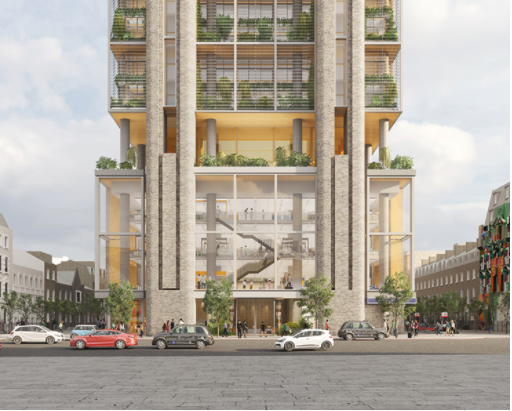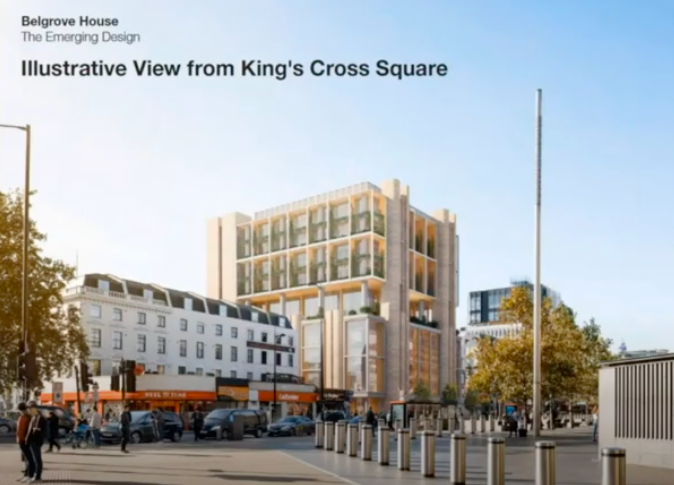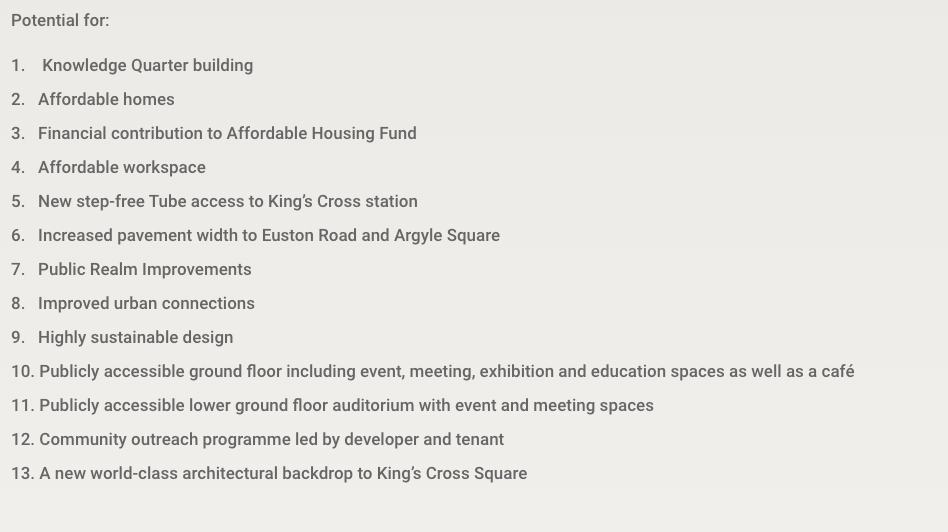Camden’s planning department are working with the developer to promote the development, and neither give a toss about heritage.
Camden’s Development Management Forum for Belgrove House was held online from 19:00 – 21:00 on 25th June.
The format of the forum differed from the usual in many ways, not least because it was held online. Most significantly of all, it was made impossible to know the questions that other people were asking or their reactions to the ongoing dialogue, making it more difficult to understand the feeling in the room towards the development.
While conventional online Q&A sessions allow for participants to make comments and questions in a shared chat space, Camden set up their online environment so that the questions and comments of others could not be seen. This allowed for Head of Development Management, Bethany Cullen, to choose questions and comments from a pool of those asked by the audience, directing the focus of the session as she saw fit.
Questioners were also unable to follow up their questions if they were not satisfied with the answer, a crucial element of Q&A.
But one thing is clear from the questions asked and answers given: there is significant concern about Belgrove House, its inappropriate scale, and lack of regard to heritage, but neither Camden’s planners nor the developer give a toss about these concerns.
While the hour-long Q&A session was provided for both Belgrove and Acorn House, almost all of the questions pertained exclusively to the Belgrove House development.
Presentations about the site and the proposed development from both Camden and the developer occupied the first hour. Camden’s Principal Planner, Gavin Sexton, described the policies pertaining to the site, but conveniently omitted the crucial policy which had implied the building should respond to the predominantly three to six storeys of the surrounding development.
The most significant piece of news was that the developers had secured a major pharmaceutical tenant for the building, Merck. While the building had previously been largely a speculative office development, with this tenant secured it is now a significant force to be reckoned with, and introduces great weight in favour of the application being approved regardless of harm to heritage.
The developer’s presentation made a brief mention of the enormous wealth of heritage surrounding the site and its ‘highly sensitive setting’, before presenting visuals of the block of glass and steel that has come to be known as the Belgrove House Monstrosity.

The justification for the building’s monstrous appearance seems to be that the development seeks to ‘represent the twenty-first century revolution, the tech revolution, just as the train stations represented the nineteenth century revolution, the industrial revolution‘, while the design also harmonises with the area’s history by representing ‘bold, industrial engineering’.
A number of similarly absurd comments were made demonstrating ignorance of the heritage of the site and how to properly relate to it.
Camden and the developer alike were instead particularly concerned with peddling the newfangled Knowledge Quarter, which seems to be something of a new antithesis to conservation areas.
The so-called ‘Knowledge Quarter’ is an area designated by Camden earlier this year, stretching from Covent Garden in the south to Camden Town in the north, and is apparently home to Camden’s ‘growing knowledge economy‘, despite this area being overwhelmingly residential.
King’s Cross Square is apparently the centre of the Knowledge Quarter.
The developer stated that the development has been ‘carefully designed to sit as a sort-of pair with the Standard Hotel‘, making no mention of the Georgian terraces immediately to the east and west, Argyle Square to the south, nor even the Victorian stations to the north.
The building is apparently constructed mainly of brick, while the upper levels comprise ‘floating terraces‘, which ‘provide a unique twenty-first century backdrop, in the sky’.

The Q&A session kicked off with a number of questions that had been piling up about the building’s inappropriate size and lack of regard to heritage.
Questions were rightly raised from the outset about the appropriateness of demolishing a building which was judged to make a positive contribution to the conservation area, and replacing it with a monolith entirely ignorant of its context.
But the developer justified demolishing the current building by stating that they were ‘looking to reuse as much of the current building as possible… as part of the demolition plan we are looking to reuse some of the brickwork… and to crush down the concrete to use it as part of the aggregates’. They added: ‘from a sustainability perspective, taking a building at the end of its economic life at 100 years old, and recycling that… is definitely the way to take it forward‘.
And while further questions were answered with developers banging on about the so-called Knowledge Quarter, one participant stated ‘the Knowledge Quarter is just a buzzword. Nobody local has heard about it’.
In response to any question about heritage the developer continued to insist the current building is somehow out-of-date, stating ‘it’s simply a building from another time’, and referred to the high tech requirements of the Knowledge Quarter which seemed to somehow always trump the requirements of the conservation areas.
I raised the question directly that it is surely absurd to put an expiry date on buildings in a conservation area when the ‘point’ of a conservation area is to conserve those buildings which are particularly old, especially those that are ‘simply from another time’.
But the developer retorted that: ‘the principle of conservation areas is not to stop development, but to carefully manage development… buildings that don’t contribute positively to the conservation area are more likely to be replaced… Camden’s own appraisal assesses the building as making a neutral contribution… that is also our view.’
It later transpired that Camden were aware of the mistake in their appraisal which had been discovered, and now consider the building to contribute positively. The misidentification of the building was described by Principal Planner Gavin Sexton as ‘a couple of inaccuracies… an error made in a document almost twenty years ago, and we’re, erm, correcting it’.
But the developer stated: ‘any positive contribution made by the building can be equally made, or better made, by a replacement building… the current building is simply not making a positive contribution, and there is the potential to make one’.
This contrast in views between the developer and planners on whether Belgrove House makes a positive contribution was significant as the only point which they did not both agree upon.
And while questions were repeatedly asked about the inappropriate height of the building and unsympathetic design given the sensitive historic context, the developer eventually pulled up a picture of the Euston Road highlighting all its post-war tall buildings, stating that ‘the Euston Road is very much about a number of large scale marker buildings… and this [building] is one of those… it completes the setting of the two stations’.

A number of concerns were raised about poor consultation, and I had to ask whether the developers had consulted with the Victorian Society and Georgian Group three times before it was answered. The developer confirmed that they had failed to consult with these key groups, who both have raised concerns about the development after I had to notify them directly myself.
I asked the last question of the Q&A by enquiring whether the large Section 106 payment, likely to be in the millions, could slant the planning process in favour of approval regardless of harm to heritage. Mr Sexton spent some time explaining what Section 106 was, and after taking a while to find his words, stated: ‘generally speaking, there isn’t a great deal of money, as such, that exchanges hands as part of a 106 agreement‘. He went on to say: ‘the harm that would be caused to the conservation area, from the loss of the existing building, would be… is required to be, balanced against public benefits…‘ He added: ‘there’s no chance that that will slant the planning process‘.
It is interesting that Mr Sexton claimed that there isn’t much money exchanged hands as part of a Section 106 agreement, considering that the last major development in the area, the Eastman Dental Hospital development, brought a £3M payment with it. It also openly states on the developer’s website that a financial contribution would be made through Section 106, listing this as one of the associated public benefits.

So we find that the planning department and the developer disagree upon whether Belgrove House makes a positive contribution to the conservation area, and whether money exchanged through Section 106 is a public benefit. But the disagreements end there. It is clear from the DMF that the planners and developers are far too comfortable with each other, both working towards the common goal of having this application approved, and steamrolling all opposition in its path.
And while the developers failed to consult with the Victorian Society and Georgian Group, it was also up to Camden’s planners to notify these groups at an early stage of development proposals, which they failed to do.
The last answer given by Camden’s planners came perilously close to admitting that heritage considerations were no longer relevant. While Mr Sexton refuted my claims about Section 106 money influencing development proposals, he almost stated that the harm caused to heritage by the development would be outweighed by the public benefit that the proposal brings, before changing his words to make the statement into a hypothetical situation.
Such a statement refers to the ultimate test which permits harmful development such as that posed by Belgrove House under Paragraph 196 of the NPPF, where public benefit is considered to outweigh harm to heritage. And while we have been trying to reinforce the gravity of the harm caused to heritage by the development, the planner has had a full eight years to hark on about public benefit to Camden’s planners, and with Merck secured as a tenant this may well be the nail in the coffin for further opposition.
Camden’s planners are not permitted to express such opinions at a Development Management Forum, explaining the sudden change in grammar to imply a hypothetical. The implication is that minds should not yet be made up, with community and interest group views having a role to play in influencing planning decisions. That’s the ‘whole point’ of the DMFs – to get community views out in the open, so that they can influence the development proposals. But it is clear that this was simply not the case at this DMF. The entire Q&A felt like Camden’s planners and the developer working as a team to refute any claims that the development might be inappropriate. Minds are made up, and as usual, the community is wrong.
While appealing to Camden’s planning department is now hopeless, we still have important interest groups on side, and can appeal directly to Camden’s planning committee where the application will inevitably end up, this year or the next. The BCAAC have been known to have success at this stage.
But the situation should raise wider questions about Camden’s planning department. Who is in control? While the planning department of a local authority is supposed to serve an advisory function to the Council’s members, with some literature even stating that planning officers are ‘community champions‘, ‘fighting for the interests of the community‘, it’s not clear who Camden’s planners serve. Themselves? The developers?
This can of worms was opened earlier this year by the controversy surrounding the members briefing panel, leading to some councillors reaching out to provide statements on the affair directly contradicting those of the planning department. It couldn’t be clearer that the planning department functions largely independently of the Council, and is perhaps even more powerful than it. As one councillor aptly put it: ‘some planners think the councillors serve an advisory function to themselves’.
Who does Camden serve?